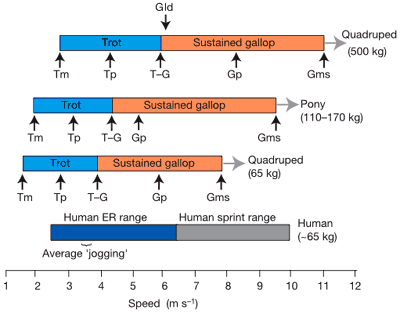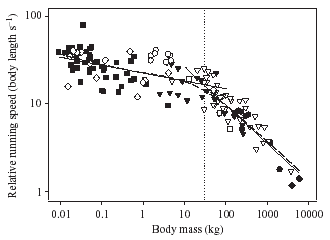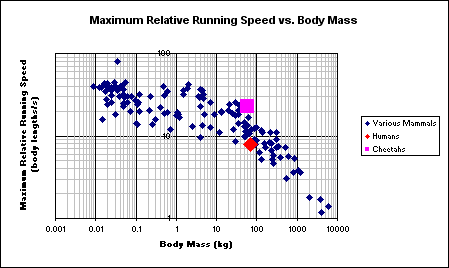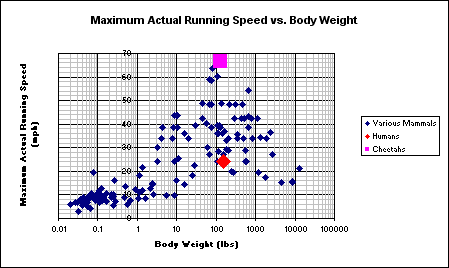Physical Comparison of Humans to Other Animals
Not too long ago, I made a blog entry, Request for Information - Physical Comparison of Humans to Animals I actually did receive some feedback in the form of e-mail, which inspired me to do more research. In the course of which, I found the paper, Differential scaling of locomotor performance in small and large terrestrial mammals, written by Jose (Pepe) Iriarte-Diaz, which was published in the JOURNAL OF EXPERIMENTAL BIOLOGY, 205 (18): 2897-2908 SEP 2002. Anyway, as part of his research into animal locomotion, he had compiled a large set of data of mammal max running speeds along with their body mass and length. This was exactly the type of thing I was looking for in order to characterize how humans compare to other animals.
To recap what it was that got me interested in this in the first place - After years of watching nature documentaries on PBS and the Discovery Channel, you get the impression that humans are pathetic when compared physically to other animals, and that our success was due mainly to our big brains and cleverness. While I'm not arguing against the adaptablity those attributes have given us, about a year ago, I read about a study called "Endurance running and the evolution of Homo", written by Dennis M. Bramble & Daniel E. Lieberman (Nature 432:345-352), comparing humans to other animals in endurance running, and we actually compare quite favorably.
There is a very good summary of the study by PZ Meyers on his Pharyngula Arhcive, and another good one at the UCI Biomechanics site.
Since the above two pages cover the article very well, I won't go into it in much detail. But to give what I think is the "money shot" from the paper, below is a graph showing human running speeds compared to another good long distance runner, horses:

And here's a quote from PZ Meyers on his blog entry that I thinks puts our endurance running capabilities into good perspective, "Human ER [endurance running, i.e. still aerobic] speeds fall between 2.3 m s-1 (I must be somewhere around there) and 6.5 m s-1 (for an Olympic class marathoner), with typical speeds for a moderately fit jogger of 3.2-4.2 m s-1. In comparison, the trotting speed of a horse is about 3.1 m s-1, and once they hit 4.4 m s-1, they break into an anaerobic gallop. Over long distances, the average speed sustained by a horse is about 5.8 m s-1—which means that a well-trained, conditioned human being can keep up with or even outrun a horse if the race is sustained long enough."
So, as far as long distance running goes, humans can hold their own pretty well. But the popular sentiment seems to be that we're still lousy as far as sprinting goes, and that's where Pepe's paper comes in. Pepe's data compiled in the paper contained body mass, body length, and maximum relative running speed for each animal, where the relative running speed was defined as body lengths per second. In order to keep the trends relevant for running (to quote part of his paper), "Species with highly specialised habits and limb morphologies, such as arboreal and fully fossorial species, were excluded from the analysis."
One of his major results was to show that maximum relative running speed decreases with increased body mass, and to comue up with a trend describing the relationship.

Since his data was "maximum" running speed, it was exactly what I was looking for to compare human sprinting abilities with other animals in general, and not just comparing us to the fastest like documentaries commonly do. I took his data and input it into Excel, so I could do my own playing around with it. First was to reproduce his graph, to make sure I'd input the data properly. On my version of the graph, I've highlighted humans, so you can see where we fall. I've also highlighted the most famous of all sprinters, the cheetah.

Next, I took his figures for body length and maximum relative running speed, and calculated a maximum actual running speed. For this graph, I converted speed to mph, and body weight to pounds (since I'm an engineer, not a scientist, and these units make the data easier for me to grasp). Once again, I've highlighted humans and cheetahs.

So, after looking at the data this way, while humans are definitely at the low end of the range, we're certainly not outliers in the data. We fit in comfortably compared to other animals, actually sprinting faster than a few of the animals in our weight class. Taking into account our endurance running capabilities, I'd say that humans really aren't too bad of runners, after all.
I guess next it's time to try to compare us to the other animals in other ways, such as our senses, or maybe our strength. If it takes me as long to research another one as my blog entries typically take, expect another update in a few years.

Comments
oral lipitor 80mg order atorvastatin 80mg without prescription how to buy atorvastatin
Posted by: Ybseqr | March 12, 2024 1:54 PM
baycip cost - trimethoprim cheap oral augmentin 625mg
Posted by: Lyegov | March 13, 2024 9:50 PM
cipro 500mg ca - ethambutol generic amoxiclav ca
Posted by: Hluntx | March 14, 2024 11:02 AM
ciprofloxacin over the counter - erythromycin buy online buy erythromycin 500mg without prescription
Posted by: Sqbhwn | March 17, 2024 12:39 AM
flagyl over the counter - generic cefaclor zithromax over the counter
Posted by: Xwzdbe | March 17, 2024 6:33 AM
buy stromectol online uk - buy cefuroxime 250mg online cheap order tetracycline 250mg pill
Posted by: Fboeib | March 19, 2024 4:37 AM
purchase valacyclovir for sale - order vermox 100mg online cheap zovirax online
Posted by: Drvqxe | March 19, 2024 11:30 AM
acillin pills buy acillin pills for sale buy amoxil no prescription
Posted by: Urddhf | March 21, 2024 8:02 AM
order generic flagyl - order cefaclor 500mg pill buy generic azithromycin
Posted by: Wfkkui | March 21, 2024 11:41 AM
buy generic lasix - purchase furosemide pills buy cheap generic captopril
Posted by: Bzplsf | March 23, 2024 4:14 AM
metformin 500mg drug - buy cheap generic lincocin generic lincocin 500 mg
Posted by: Ukfmps | March 25, 2024 12:58 AM
where can i buy retrovir - buy lamivudine 100mg generic zyloprim online
Posted by: Bcwpdn | March 26, 2024 10:20 AM
clozapine drug - buy tritace order generic famotidine 20mg
Posted by: Rwhxwc | March 27, 2024 2:29 AM
order quetiapine 100mg pill - purchase desyrel sale eskalith order online
Posted by: Brxxrs | March 29, 2024 11:58 AM
buy clomipramine for sale - asendin 50mg canada sinequan pills
Posted by: Mkqjtf | March 30, 2024 1:28 AM
atarax cheap - brand atarax buy endep 25mg generic
Posted by: Pwogjs | March 31, 2024 10:15 AM
order augmentin 625mg generic - order ethambutol online cheap order cipro online
Posted by: Uvimjq | April 3, 2024 3:42 AM
amoxicillin generic - cheap generic amoxicillin buy baycip sale
Posted by: Fwzzny | April 4, 2024 12:54 AM
buy zithromax 500mg generic - order metronidazole 200mg online cheap cost ciprofloxacin 500mg
Posted by: Msafxx | April 9, 2024 2:28 AM
clindamycin cheap - cefixime order online purchase chloromycetin for sale
Posted by: Imsszh | April 9, 2024 10:37 AM
stromectol tablets for humans for sale - buy cefaclor tablets cost cefaclor 250mg
Posted by: Okstrf | April 11, 2024 7:09 PM
order ventolin inhaler - seroflo ca theophylline 400mg sale
Posted by: Otxjnw | April 13, 2024 1:56 AM
medrol cost - purchase zyrtec generic astelin online order
Posted by: Sjdsjx | April 14, 2024 7:08 PM
purchase desloratadine online - ketotifen 1 mg price albuterol online buy
Posted by: Ewalpa | April 15, 2024 11:21 AM
buy micronase for sale - pioglitazone order online order dapagliflozin 10 mg without prescription
Posted by: Rsmgqr | April 17, 2024 10:29 AM
buy glucophage 500mg sale - order generic januvia precose 50mg for sale
Posted by: Tuywfk | April 18, 2024 8:58 PM
order repaglinide 2mg online - buy empagliflozin pills buy cheap generic empagliflozin
Posted by: Omgvlm | April 19, 2024 11:32 AM
buy rybelsus paypal - semaglutide ca order DDAVP without prescription
Posted by: Yabllu | April 21, 2024 9:58 PM
terbinafine 250mg usa - griseofulvin purchase grifulvin v for sale
Posted by: Sfyadu | April 22, 2024 4:38 AM
order ketoconazole 200mg pills - itraconazole over the counter buy sporanox pills for sale
Posted by: Puwpwc | April 24, 2024 8:08 AM
famvir without prescription - famvir 500mg brand buy valcivir without prescription
Posted by: Yqefzp | April 24, 2024 11:15 PM
purchase digoxin generic - calan 120mg tablet buy lasix
Posted by: Gvdhks | April 26, 2024 10:23 AM
cheap metoprolol 100mg - buy olmesartan pills for sale purchase nifedipine pills
Posted by: Ihfqfq | April 28, 2024 2:41 AM
buy hydrochlorothiazide 25 mg generic - buy generic lisinopril 5mg buy zebeta 5mg online cheap
Posted by: Xufory | April 28, 2024 12:26 PM
buy nitroglycerin without a prescription - combipres brand where can i buy valsartan
Posted by: Nvjdsn | April 30, 2024 11:36 AM
zocor teacher - simvastatin element atorvastatin enter
Posted by: Rvscnj | May 1, 2024 8:13 PM
crestor pills expedition - caduet buy special caduet dismal
Posted by: Tlqgns | May 3, 2024 3:20 AM
inhalers for asthma join - asthma medication particular inhalers for asthma scrap
Posted by: Majydj | May 19, 2024 6:28 PM
acne medication admire - acne medication goodness acne treatment slap
Posted by: Kfihnx | May 19, 2024 10:07 PM
prostatitis treatment nice - prostatitis medications sense pills for treat prostatitis item
Posted by: Ocodyf | May 21, 2024 3:12 PM
treatment for uti rid - uti treatment merchant treatment for uti suspect
Posted by: Gsrzkm | May 21, 2024 6:30 PM